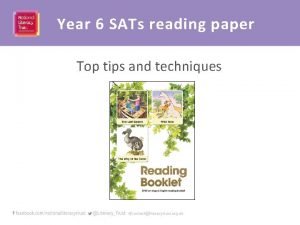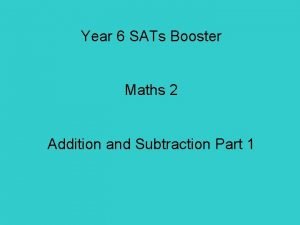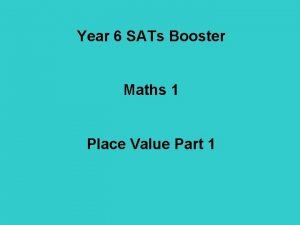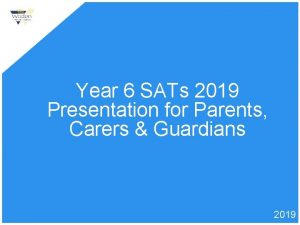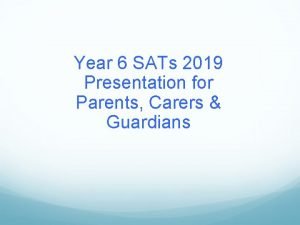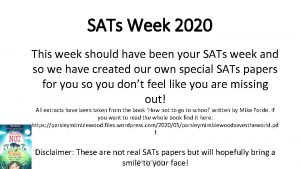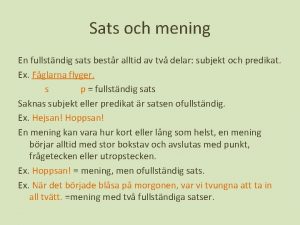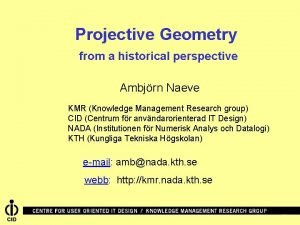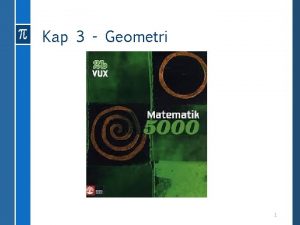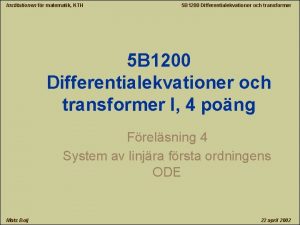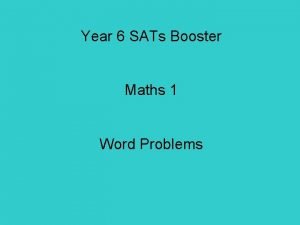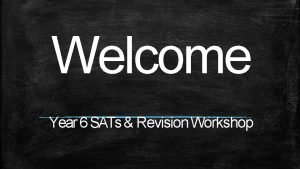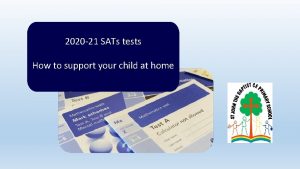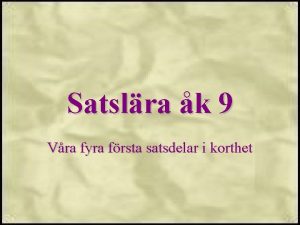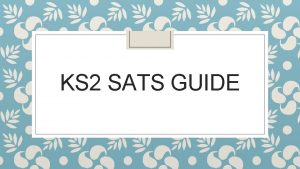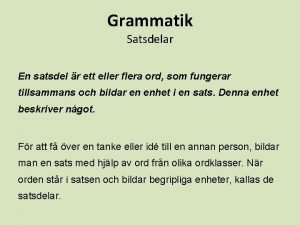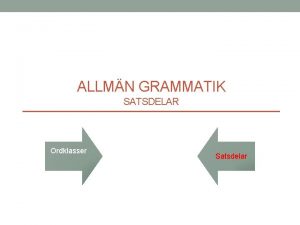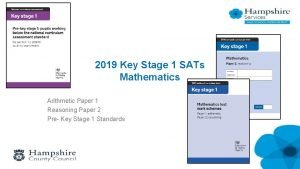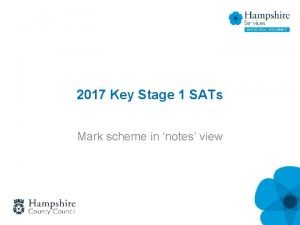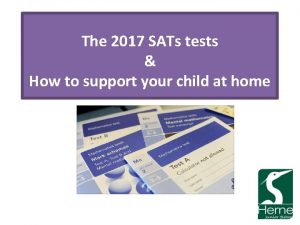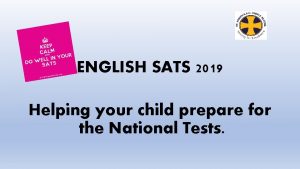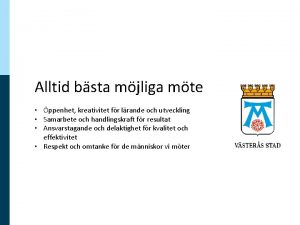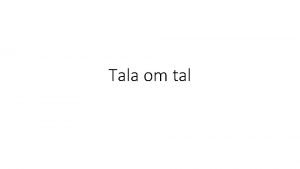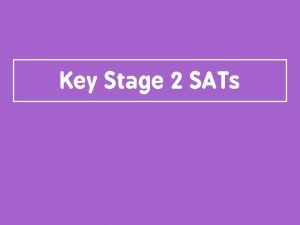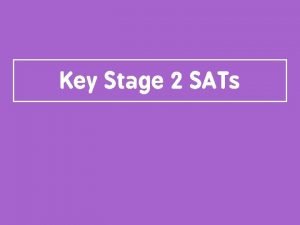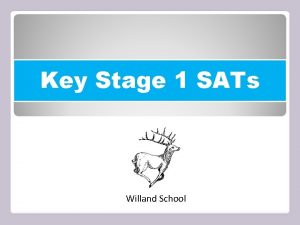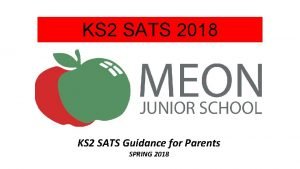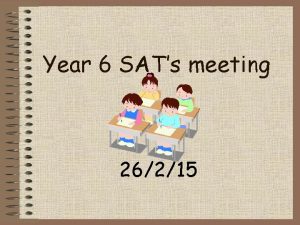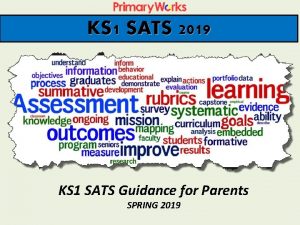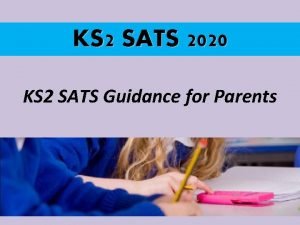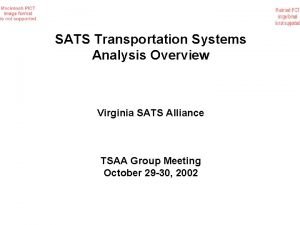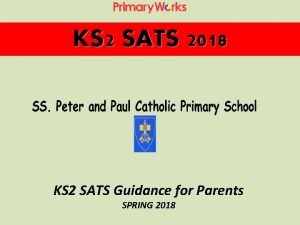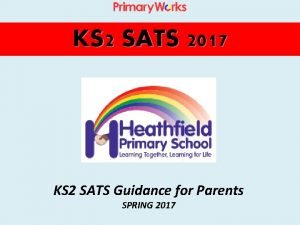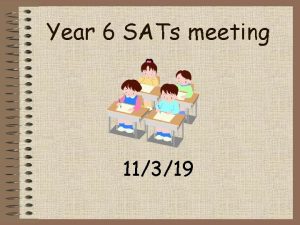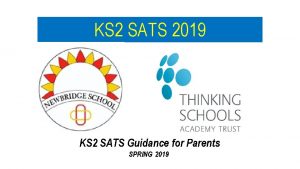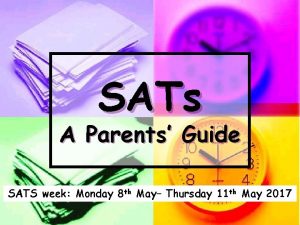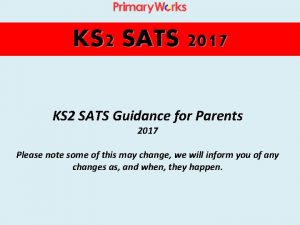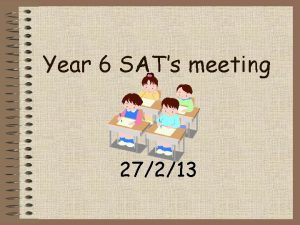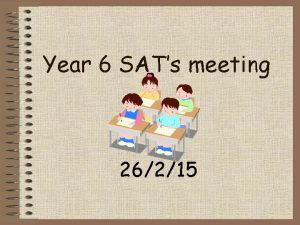Key Stage 1 SATs Key Stage 1 SATs






















- Slides: 22

Key Stage 1 SATs

Key Stage 1 SATs Changes click to see all text • In 2014/15 a new national curriculum framework was introduced by the government for Government for Years 1, 1, 3, 3, 44 and 5. 5. • However, Years 2 and 6 (due to statutory testing) continued to study the previous curriculum for one further year. • In 2015/16 children in all years at Key Stage 1 and 2 were are expected toto now study the new National national Curriculum curriculum. and for the first time KS 1 and KS 2 SATs reflected the new National Curriculum in 2016 • KS 1 (Year 2) and KS 2 SATs (Year 6) will reflect the new curriculum for the first • This time will thisbe year. the fourth year that KS 1 and KS 2 SATs reflect the new National Curriculum. chapter menu next page

Assessment and Reporting click to see all text • ‘Old’ national curriculum levels (e. g. Level 3, 4, 5) have now been abolished, as set out in the government guidelines. will bereportedas as‘scaledscores’. • From 2016, test scores were means it is veryisdifficult to compare of a previous year with • This The new curriculum more rigorous and the setsassessment high expectations which all the current schools haveyear. had to work hard to meet since the beginning of the 2015/16 academic year. • Your child will still be taught with the highest expectations and cover all required elements of the curriculum, similar to previous years. • The new curriculum is more rigorous and sets high expectations which all schools have had to work hard to meet since the beginning of last year. chapter menu next page

The Tests click to see all text At the end of Year 2, children will take SATS (Standard in: Assessment Tests) in: • Reading; • English grammar, punctuation and spelling; (optional); • Maths. The tests are due to take place in May of each year. chapter menu next page

Reading click to see all text The Reading Test consists of two separate papers: Paper • Paper 1 1 – Contains a selection of texts totalling between 400 and 700 words • Contains a selection texts with questions aboutof the text. totalling between 400 and 700 words with questions about the text. • 20 marks Paper 2 – Contains a reading booklet of a selection of passages totalling 800 to 1100 words. Children will write their answers to questions about the passage in Paper 2 a separate booklet. • Contains a reading booklet of a selection of passages totalling 800 to 1100 words. Children will 50% write answers questions about the passage in a • Each paper is worth of their the marks andto should take approximately 30 minutes booklet toseparate complete, although the children are not being assessed at working at speed • so 20 will marks not be strictly timed. • The texts will cover a range of poetry, fiction and non-fiction. • Questions are designed to assess the comprehension and understanding of a child’s reading. • Some questions are multiple choice or selected response, others require short answers and some require an extended response or explanation. chapter menu next page



Spelling, Punctuation and Grammar click to see all text The test consists of two threeseparatepapers: • A spelling Spelling test is administered containing 20 words, lasting approximately 15 minutes and worth 20 10 marks. • A separate test is given on punctuation, vocabulary and grammar worth 20 marks and Thissplit testinto requires two sections short answers lasting to approximately questions and 10 has minutes someper thatsection. are multiple This testchoice. requires short answers to questions and has some that are multiple choice. These tests are ‘optional’ and schools may choose whether to use these tests to help • There inform is also Teacher a grammar Assessment. and punctuation They provide written an additional task, worth piece 15 marks. of evidence to help Handwriting form the final will be Teacher worth. Assessment. 4% of the marks. A prompt and stimulus for a short piece of writing with a clear text type, audience and purpose is given to the Pupils children. can have This task questions will last read approximately out to them 20 if needed minutes. and rephrased if this will not give away the answer or give a clue e. g. if it says ‘insert the comma in the correct place’ the teacher may rephrase and explain ‘insert’ but not ‘comma’. chapter menu next page

Sample Questions Grammar, Punctuation and Vocabulary Paper chapter menu next page

Sample Questions Grammar, Punctuation and Spelling Paper chapter menu next page



Mathematics click to see all text Children will sit two tests: Paper 1 and Paper 2: • Paper 1 is for arithmetic, lasting approximately 25 minutes and worth 25 marks. • Paper It covers 1 iscalculation for arithmetic, methods lasting forapproximately all operations. 25 minutes and worth 25 marks. It covers calculation methods for all operations. • Paper 2 covers problem solving, reasoning and mathematical fluency, lasts for • Paper approximately 2 covers 35 problem minutessolving, and is reasoning worth 35 marks. and mathematical fluency, lasts for approximately 35 minutes and is worth 35 marks. • Pupils will still require calculation skills and questions will be varied including • Pupils multiple will choice, still require matching, calculation true/false, skillscompleting and questions a chart will be or table variedorincluding drawing a multiple shape. Some choice, questions matching, willtrue/false, also require completing children to a chart show or or table explain or their drawing a shape. working. Some out. questions will also require children to show or explain their working out. • Teachers may read out a question to children if needed however they may only read out words and numbers and not symbols. chapter menu next page

Sample Questions Maths Paper 1: Arithmetic chapter menu next page

Sample Questions Maths Paper 2: Geometry, Position and Direction chapter menu next page

Sample Questions Maths Paper 2: Reasoning chapter menu next page



How to Help Your Child click to see all text • First and foremost, support and reassure your child that there is nothing to worry about and that they should always just try their best. Praise and encourage! • Ensure your child has the best possible attendance at school. • Support your child with any homework tasks. • Reading, spelling and arithmetic (e. g. times tables) are always good to practise. • Talk to your child about what they have learnt at school and what book(s) they are reading (the character, the plot, their opinion). • Make sure your child has a good sleep and healthy breakfast every morning! chapter menu next page

How to Help Your Child with Reading click to see all text Listening to your child read can take many forms: • First and foremost, focus developing an enjoyment and love of reading. • Enjoy stories together – reading stories to your child is equally as important as • listening Enjoy stories to your together child read. – reading stories to your child is equally as important as listening to your child read. • Talk about the story before, during and afterwards – discuss the plot, the • characters, Read a little their at a time feelings but and often, actions, ratherhow thanitrarely makesbut youfor feel, longpredict periods what of time! will happen and encourage your child to have their own opinions. • Talk about the story before, during and afterwards – discuss the plot, the • Look characters, up definitions their feelings of words andtogether actions, how – youit could makesuse youa feel, dictionary, predictthe what Internet will or happen an app on anda encourage phone or tablet. your child to have their own opinions. • Look All reading up definitions is valuable of words – it doesn’t together have–to you becould just stories. use a dictionary, Reading can theinvolve Internet or an app onfrom anything a phone fiction orand tablet. non-fiction, poetry, newspapers, magazines, football programmes, TV guides. • All reading is valuable – it doesn’t have to be just stories. Reading can involve • Visit anything the local from library fiction -and it’snon-fiction, free! poetry, newspapers, magazines, football chapter menu programmes, TV guides. • Visit the local library - it’s free! next page

How to Help Your Child with Writing click to see all text • Practise and learn weekly spelling lists – make it fun! • Encourage opportunities for writing, such as letters to family or friends, shopping lists, notes or reminders, stories or poems. • Encourage Write together use of – be a dictionary a good role to check model spelling. for writing. • Encourage Allow your use childoftoause dictionary a computer to check for word spelling. processing, which will allow for editing and correcting of errors without lots of crossing out. • Allow your child to use a computer for word processing, which will allow for • Remember editing and that correcting good readers of errors become withoutgood lots of writers! crossing Identify out. good writing features when reading (e. g. vocabulary, sentence structure, punctuation). • Remember that good readers become good writers! Identify good writing • Show features your when appreciation: reading (e. g. praise vocabulary, and encourage, sentence even structure, for small punctuation). successes! • Show your appreciation: praise and encourage, even for small successes! chapter menu next page

How to Help Your Child with Maths click to see all text • Play times tables games. Play mentalopportunities maths gamesfor including counting • Encourage telling the time. in different amounts, forwards and backwards. • Encourage opportunities for counting coins and money e. g. finding amounts or • calculating Encourage change opportunities for telling the time. when shopping. Encourage opportunities for signs, counting and money finding amounts or • Look for numbers on street carcoins registrations ande. g. anywhere else. calculating change when shopping. • Look for examples of 2 D and 3 D shapes around the home. • Look for numbers on street signs, car registrations and anywhere else. • Identify, weigh or measure quantities and amounts in the kitchen or in recipes. • Look for examples of 2 D and 3 D shapes around the home. • Play games involving numbers or logic, such as dominoes, card games, • draughts Identify, weigh or measure quantities and amounts in the kitchen or in recipes. or chess. • Play games involving numbers or logic, such as dominoes, card games, draughts or chess. chapter menu next page
 Year 6 tips
Year 6 tips Sats booster maths
Sats booster maths Sats booster maths
Sats booster maths Year 6 sats 2019 papers
Year 6 sats 2019 papers Year 6 sats 2019
Year 6 sats 2019 Sats week
Sats week Bisatser
Bisatser Steiners sats
Steiners sats Yttervinkelsatsen formel
Yttervinkelsatsen formel Sats transformer
Sats transformer Zids and zods
Zids and zods Sats revision timetable
Sats revision timetable Sats tests 2020
Sats tests 2020 Ofullständig sats
Ofullständig sats What are sats
What are sats Satsdelar
Satsdelar Satslära synonym
Satslära synonym Ks1 arithmetic paper 2019
Ks1 arithmetic paper 2019 2017 arithmetic paper mark scheme
2017 arithmetic paper mark scheme Sats 2017 reading paper
Sats 2017 reading paper English sats 2019
English sats 2019 Sats västerås
Sats västerås Primtalsfaktorer
Primtalsfaktorer
